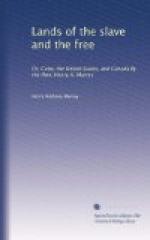The misery which an instantaneous deliverance of the slave would cause by the all but certain loss of the greater portion of the products above enumerated, must be apparent to the least reflecting mind. If any such schemer exist, he would do well to study the history of our West India islands from the period of their sudden emancipation, especially since free-trade admitted slave produce on equal terms with the produce of free labour. Complaints of utter ruin are loud and constant from the proprietors in nearly every island; they state, and state with truth, that it is impossible for free labour at a high price, and which can only be got perhaps for six hours a day, to compete with the steady slave work of twelve hours a day; and they show that slaveholding communities have materially increased their products, which can only have been effected by a further taxing of the slave’s powers, or a vast increase of fresh human material.[BX] But they further complain that the negro himself is sadly retrograding. “They attend less to the instruction of their religious teachers; they pay less attention to the education of their children; vice and immorality are on the increase,” &c.—Petition to the Imperial Parliament from St. George’s, Jamaica, July, 1852.
I might multiply such statements from nearly every island, and quote the authority of even some of their governors to the same effect; but the above are sufficient for my purpose. They prove three most important facts for consideration, when treating the question of Slavery. First, that you may ruin the planter. Secondly, that you may free—without benefiting—the slave. Thirdly, that each State, as it becomes free, tends to give additional value to the property of those States which choose to hold on to slavery; and all these results may occur despite the wisdom (?) of senators, and an indemnity of 20,000,000l.
Surely, then, the Southern planter may well assert that he sees not sufficient inducement to follow our hasty wholesale example. But while such convictions are forced upon him, he will be a degenerate son of energetic sires, if he be so scared at our ill-success as to fear to look for some better path to the same noble object; and there is one most important consideration which should impel him, while avoiding all rash haste, to brook no dangerous delay; that consideration is, that the difficulty of dealing with the question is increasing with fearful rapidity, for the slave population has nearly quadrupled itself since the beginning of the century. The capital involved is, we have seen, gigantic; but the question of numbers is by far the most perplexing to deal with, in a social point of view. The white population of the Slave States is, in rough numbers, 6,000,000; the slave population is more than 3,000,000, and the free blacks 250,000. Does any sane man believe that, if slavery had existed in Great Britain, and that the slaves had constituted one-third of the population, we should have attempted to remove the black bar from our escutcheon, by the same rapid and summary process which we adopted to free the negro in our colonies?




